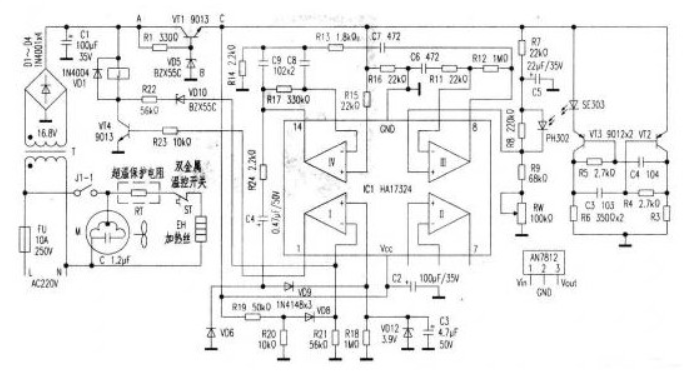FEEGOO Hand dryer is a sanitary appliance for drying hands or drying hands in bathroom. It is divided into induction automatic hand dryer and manual hand dryer. It is mainly used in hotels, restaurants, scientific research institutions, hospitals, public entertainment places and the bathroom of each family. A wind guide device is set at the air outlet of the hand dryer, and there are air guide blades on the air guide device. Program.
The working principle of the hand dryer is generally that the sensor detects a signal (hand), which is controlled to open the heating circuit relay and the blowing circuit relay, and start heating and blowing. When the signal detected by the sensor disappears, the contact is released, the heating circuit and the blowing circuit relay are disconnected, and the heating and blowing are stopped. The heating-based and high-speed air-drying hand dryers are mainly heated. Usually, the heating power is relatively large, above 1000W, while the motor power is very small, only less than 200W. This kind of FEEGOO hand dryer is typical The characteristic is that the wind temperature is very high, and the water on the hand is taken away by the relatively high temperature wind. This method dries the hands slowly, usually in more than 30 seconds. It is a little noisy, so it is affected by the office buildings and other needs of quiet space. favor.
Fault phenomenon 1:
Put your hand into the hot air outlet, no hot air is blown out, only cold air is blown out.
Analysis and maintenance: There is cold air blowing out, indicating that the blower motor is powered and working, and the infrared detection and control circuit is normal. There is only cold air, indicating that the heater is open circuit or the wiring is loose. After inspection, the heater wiring is loose. After reconnecting, there is hot air blowing out, and the fault is eliminated.
Fault phenomenon 2:
After power-on. Hands are not yet on the hot air outlet. The hot air blows out of control.
Analysis and maintenance: After investigation, there is no breakdown of the thyristor. After replacing the optocoupler, the work returned to normal, and the fault was eliminated.
Fault phenomenon 3:
The hand is put into the hot air outlet, but no hot air is blown out.
Analysis and maintenance: check that the fan and heater are normal, check that the gate of the thyristor has no trigger voltage, and check that the c-pole of the control triode VI has a rectangular wave signal output. , ④ The forward and reverse resistances between the pins are infinite. Normally, the forward resistance should be several m, and the reverse resistance should be infinite. It is judged that the internal photosensitive tube is open circuit, resulting in the gate of the thyristor not getting the trigger voltage. Can’t turn on. After replacing the optocoupler, the problem is solved.
In order to facilitate maintenance, the circuit of the machine is analyzed, and the circuit diagram is drawn (see the attached picture).
And introduce common fault causes and simple solutions for reference.
1. the circuit principle
In the circuit, a 40kHz oscillator is formed by V1, V2, R1, and C3, and its output drives the infrared tube D6 to emit 40kHz infrared light. When the human hand reaches under the hand dryer, the infrared rays reflected by the hand are received by the photocell D5. Convert it into a half-wave pulsating DC signal. The signal is coupled to the positive input terminal of the first-stage operational amplifier through C4 for amplification, and a small bias voltage is added to the negative terminal to prevent small signal interference. The amplified signal is output from the ① pin to R7, D7, C5 for shaping and smoothing to become a DC signal. It is sent to the positive input terminal of pin ⑤ of the second stage op amp for comparison and amplification. The flipping threshold of the second-stage op amp is determined by the voltage divider of R9 and R11 connected to the negative input terminal of pin ⑥. R10 is the positive feedback resistor of the op amp, and together with C5 and C6 form a delay circuit to prevent the detected hand from moving. The resulting interference results in a power outage. When the operational amplifier pin ⑦ outputs a high level, V3 is turned on. The control relay turns on power to the heater and blower.
2. Common fault causes and troubleshooting
Fault 1: The indicator light is on after the power is turned on. But no hot air came out after reaching out.
Analysis of the possibility that the fan and the heater will fail at the same time is very small. It is usually because the relay is broken or does not operate. If J does not operate, it may mean that V3 is not conducting; the operational amplifier has no output; D6 and D5 fail; V1 and V2 do not start to vibrate. Or 7812 is damaged resulting in no 12V voltage.
When checking, first check whether there is 12V voltage. If there is, reach out to test and check whether the level of pin ⑦ of the operational amplifier has changed. If there is a change, check V3 and relay backward; if there is no change, check the operational amplifier circuit, photoelectric conversion and oscillation circuit forward.
Fault 2: After the power is turned on, the indicator light is on. But the induction sensitivity is low.
In addition to the abnormality of the operational amplifier circuit, this fault is often caused by the red emission and receiver tubes being polluted by dust. Just wash it.
Post time: Oct-29-2022











